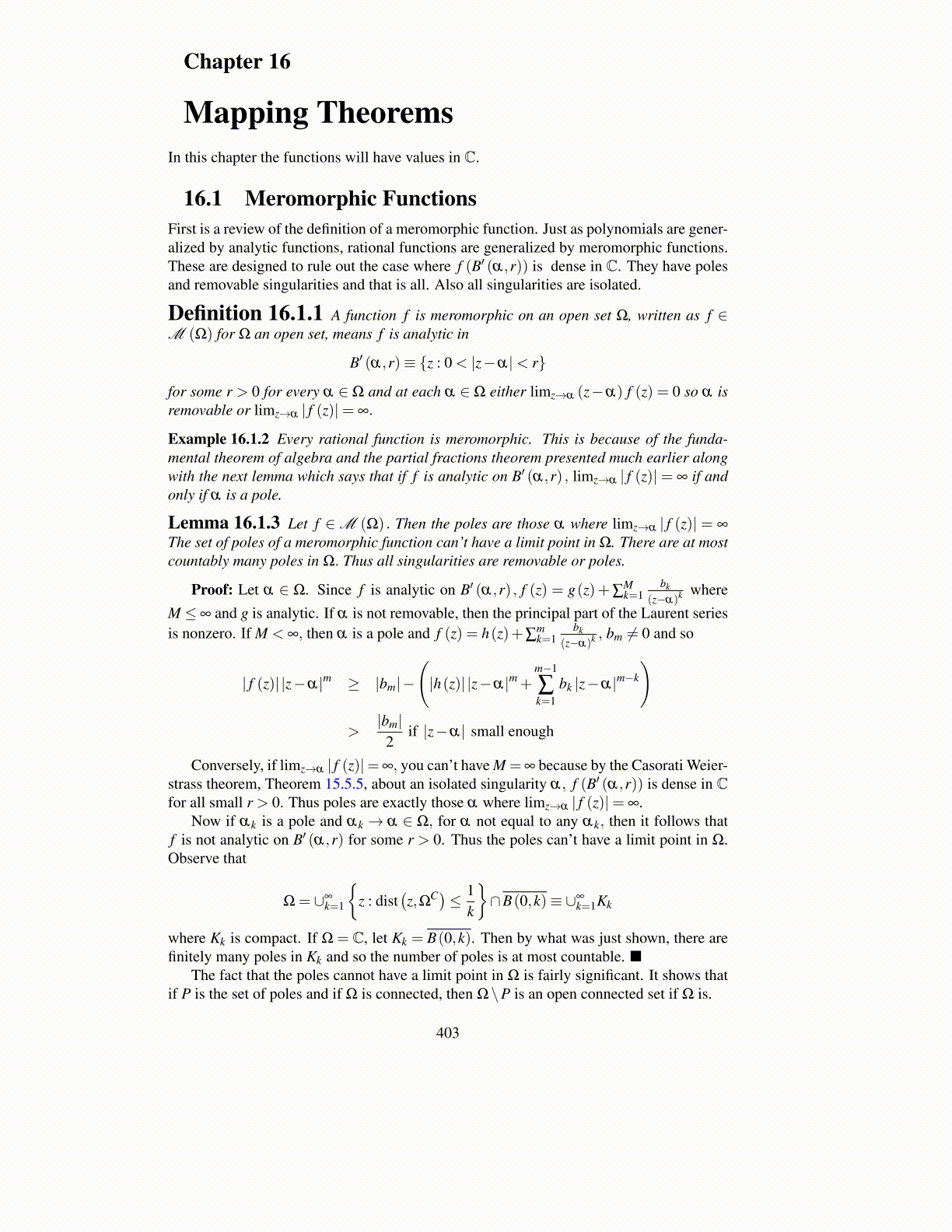
Chapter 16
Mapping TheoremsIn this chapter the functions will have values in C.
16.1 Meromorphic FunctionsFirst is a review of the definition of a meromorphic function. Just as polynomials are gener-alized by analytic functions, rational functions are generalized by meromorphic functions.These are designed to rule out the case where f (B′ (α,r)) is dense in C. They have polesand removable singularities and that is all. Also all singularities are isolated.
Definition 16.1.1 A function f is meromorphic on an open set Ω, written as f ∈M (Ω) for Ω an open set, means f is analytic in
B′ (α,r)≡ {z : 0 < |z−α|< r}
for some r > 0 for every α ∈ Ω and at each α ∈ Ω either limz→α (z−α) f (z) = 0 so α isremovable or limz→α | f (z)|= ∞.
Example 16.1.2 Every rational function is meromorphic. This is because of the funda-mental theorem of algebra and the partial fractions theorem presented much earlier alongwith the next lemma which says that if f is analytic on B′ (α,r) , limz→α | f (z)| = ∞ if andonly if α is a pole.
Lemma 16.1.3 Let f ∈M (Ω) . Then the poles are those α where limz→α | f (z)| = ∞
The set of poles of a meromorphic function can’t have a limit point in Ω. There are at mostcountably many poles in Ω. Thus all singularities are removable or poles.
Proof: Let α ∈ Ω. Since f is analytic on B′ (α,r) , f (z) = g(z)+∑Mk=1
bk(z−α)k where
M ≤∞ and g is analytic. If α is not removable, then the principal part of the Laurent seriesis nonzero. If M < ∞, then α is a pole and f (z) = h(z)+∑
mk=1
bk(z−α)k , bm ̸= 0 and so
| f (z)| |z−α|m ≥ |bm|−
(|h(z)| |z−α|m +
m−1
∑k=1
bk |z−α|m−k
)
>|bm|
2if |z−α| small enough
Conversely, if limz→α | f (z)|=∞, you can’t have M =∞ because by the Casorati Weier-strass theorem, Theorem 15.5.5, about an isolated singularity α, f (B′ (α,r)) is dense in Cfor all small r > 0. Thus poles are exactly those α where limz→α | f (z)|= ∞.
Now if αk is a pole and αk → α ∈ Ω, for α not equal to any αk, then it follows thatf is not analytic on B′ (α,r) for some r > 0. Thus the poles can’t have a limit point in Ω.Observe that
Ω = ∪∞k=1
{z : dist
(z,ΩC)≤ 1
k
}∩B(0,k)≡ ∪∞
k=1Kk
where Kk is compact. If Ω = C, let Kk = B(0,k). Then by what was just shown, there arefinitely many poles in Kk and so the number of poles is at most countable. ■
The fact that the poles cannot have a limit point in Ω is fairly significant. It shows thatif P is the set of poles and if Ω is connected, then Ω\P is an open connected set if Ω is.
403